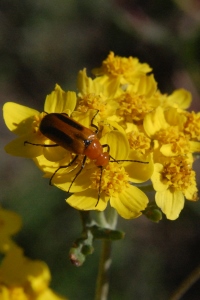
Deutschman Lab Projects
Blister beetles are medium-sized beetles (3-70 mm), with a variety of colors and forms. The abdomen generally extends beyond the leathery elytra, giving the body a softer feel than most other beetles. They earned their name due to the toxin, cantharidin, that can cause blistering of human skin. Human health issues involving meloids have a long-documented and colorful history, as cantharidin from Lytta vesicatoria, or the "Green Spanish-fly," has been erroneously used as an aphrodisiac or cure for impotency. However, consumption of cantharidin leads to serious health issues including death. This toxicity can also poses problems for livestock when the beetles feed on alfalfa and are subsequently incorporated into hay.
Blister beetles exhibit an interesting dichotomy of larval development and hosts/prey. The larvae of most genera feed on the provisions and larvae of native ground nesting bees, however, the larvae of other genera feed on grasshopper eggs. Adults are phytophagous, feeding on a combination of stems, leaves, and flowers, including petals, pollen, or nectar; food plant specificity and the part(s) of the plant consumed vary among species. Foraging and mating aggregations often form on the food plants but may be short-lived. These aggregations can number in the hundreds of individuals and sometimes complete disperse within a day.
Initial work is focusing on identifying the blister beetle species which inhabit San Diego County and possibly extending this to the entire state of California. Methods include field collecting and reviewing previously collected specimens at other collections (e.g. museums). In addition to developing a species list and distribution for each species, field surveys will more completely describe food plants and other biological aspects of these beetles.
Research Tasks
1. Document as many blister beetle species in San Diego County and/or California as possible
2. More accurately describe the geographic distribution, habitat (including food plants), and phenology
Lead Biologist: Daniel Marschalek
Ecological and Taxonomic Research of Blister Beetles (Meloidae)
